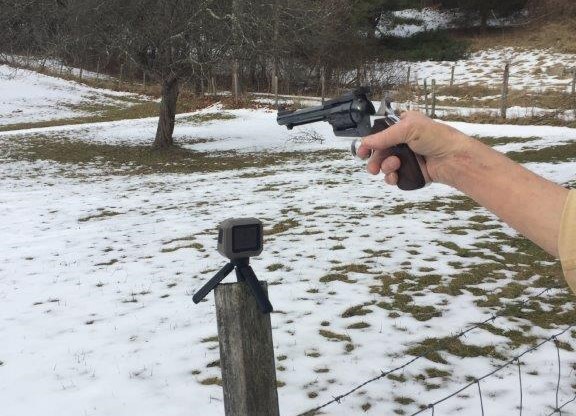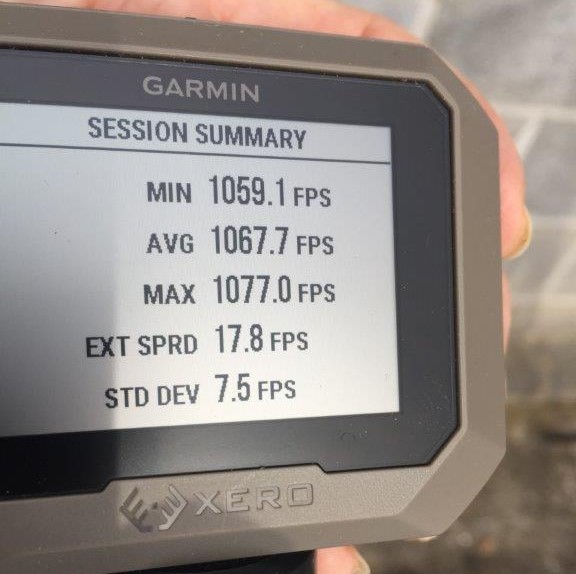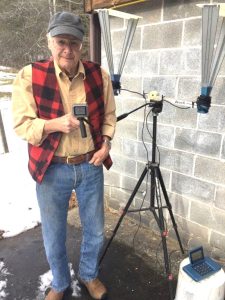
By John Markwell | Contributing Writer
We have always put off working with a chronograph until we had enough different loads to make the set-up hassle worth the time.
Having owned two different Shooting Chrony units (shot the first) and now a CED unit, we just never warmed up to chronographing loads like some folks. Then again, keeping things simple has always been our credo. The Garmin XERO C1 PRO chronograph that was delivered last week has changed our outlook on chronograph use.
To get the CED unit ready to use, we had to first wrestle it out of the cellar under the gun room and get it out onto the concrete deck. Even though the CED’s sky screens are permanently attached to a tripod, this is usually a bit of a pain in then neck. Then the control/sensor unit needs to be plugged in to the wires attached to the sky screens and the screens, and even with the light diffusers already inserted, they need to be unfolded and aligned in the direction of fire.
Then, assuming there is no issue with the day’s lighting, the CED is ready to rock while the shooter sends lead over the unit..
In contrast, here’s the rundown on our first use of the Garmin XERO C1 PRO. There are only four buttons on top of the XERO with a USB-C charging port on the side. They include a power button, an “OK” button to select menu items and two up/down buttons for scrolling though the menu.
With the XERO fully charged, we selected “new session,” then “pistol mode.” Next we selected “velocity range” and after that a “pistol alignment” diagram appears, followed by a prompt to set the data fields; we chose “average,” “extreme spread” and “standard deviation.” All of this was accomplished in the comfort of the gun room in about a minute, maybe two. Another press of the “OK” button and the XERO was ready to go to work.

We grabbed one of our current project revolvers and loaded the Single Six with five rounds of .32 H&R Magnum handloads and went out the door. The XERO was placed on top of a fence post next to the deck and the ensuing five shots were fired with the revolver about eight inches above the chronograph, which was facing the direction of fire with the screen towards the shooter. Time out in the 20-degree weather was less than a minute and we had the data for the five shots. Pretty painless and easy; even for a technologically challenged “geezer”.

The XERO PRO weighs in at only 5.6 ounces and will literally fit in a shirt pocket. This miniature doppler radar unit is capable of clocking the speed of all types of projectiles; arrows, bullets (both rifle and handgun), air gun BBs and pellets, muzzle loader bullets, shotgun shot loads and slugs and even stuff launched from slingshots.
Powered by a rechargeable lithium Ion battery, the unit will run for four hours when fully charged and can be paused between strings to conserve energy. The XERO will give the user more information than this scribe really needs; average velocity (what we will use most), deviation from average, extreme spread, kinetic energy, maximum/minimum velocity, power factor and standard deviation.
The XERO can be paired with the user’s smart phone or tied into one’s computer. We could go on about the unit’s features and capabilities but instead refer readers to the Garmin folks’ helpful website at: garmin.com/manuals/xeriC1.
The true beauty of this compact little chronograph is truly it’s size. Easily stowed in a pack or shooting bag, there is no reason not to take this device with you to the range all the time.
It will be interesting to see what accessories appear in the future for the XERO. We have already seen a rifle mount allowing the XERO to be mounted on the left side of an AR via a Pic rail. MSRP on the Garmin XERO C1 is $599 and they are currently hard to find. We are looking forward to further testing of our XERO C1; so stay tuned.





